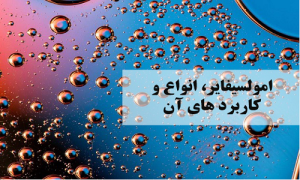Allowed chemical additives in the food industry:
There are different types of chemical food additives, we will talk about one of them below. The purpose of these additives is to improve the appearance and consistency of foods and to increase their storage quality. Their task is to prevent the merging of suspended droplets and break the emulsion.

Emulsifier, its types and uses:
In general, emulsifiers are closely related to stabilizers (substances that maintain the emulsified state). Emulsifier (Emulsifier) is a chemical additive that causes a liquid to be suspended in another liquid, such as a mixture of water and oil. These additives are included in the group of surfactants or surface active substances. They exist in the form of powder, granules or liquid that dissolve in solution. The two main groups of these materials include oil-in-water in the form of oil droplets suspended in a water base (similar to milk or body lotion) and water-in-oil in the form of very small water droplets in a fat-based material (very thick and greasy).
Their main structure is a hydrophobic part (usually a fatty acid) and a hydrophilic part (they can be charged or uncharged). Their hydrophobic part is soluble in oil and their hydrophilic part is soluble in water. Some of these compounds such as algin, carrageenan and agar are derived from algae. Usually, these ingredients are used in sweets, ice cream, margarine and salad dressings.
normal:
Its natural types are usually used for food or skin products. But these materials go through various chemical processes before being used in any product. The most common natural emulsifiers are egg yolk, mustard, soy lecithin, trisodium phosphate, mono and diglyceride, Tween 80 (polysorbate) and sodium stearoyl lactylate.
artificial:
Its synthetic type is mostly used for mixing in paints and fire extinguishing liquids and is not used in cosmetic, pharmaceutical and food products.

The difference between the use of natural and synthetic emulsifiers:
Its natural types are used in food and health products, while its synthetic types are not suitable for these purposes.
Application of emulsifier:
Emulsifiers are used in the food industry, preparation of cosmetics, lotions, medicines and paints.
Food industry:
One of the first natural emulsifiers that people used was egg yolk. The lecithin in it is a combination of natural phospholipids used in the food industry as an emulsion. Due to the low shelf life of this product, people switched to lecithin derived from soybeans. With the advancement of science, mono and diglyceride, which were derived from fatty acids, came into use. Proteins, fatty acid esters, sodium stearoyl lactylate and acetic acid are other common emulsifiers in foods.
These ingredients are used in breads, ice cream, salad dressings, chocolate, margarine and other everyday foods. Their use in the food industry is carried out with great obsession. For example, they often use pure natural types or synthetic types with a chemical structure similar to natural products. Carboxymethylcellulose or CMC for short is one of the emulsifiers used in the food industry for the production of ice cream.
Salad dressings:
For years, cooks used natural emulsifiers such as egg yolk, mustard or honey to prepare salad dressings. These additives cause the formation and stabilization of oil-in-water emulsions (mayonnaise) and distribute the flavoring compounds evenly.
Ice cream:
Emulsifiers prevent the formation of large ice crystals in frozen products (ice cream) and improve their volume and uniformity.
It also causes resistance to thermal shock and increases the ability to maintain the shape of ice cream.
Cake:
One of the uses of natural emulsifiers is their use in cakes and sweets. There is always water or milk, oil, sugar, flour and eggs in the recipe for the preparation of cake batter;
Bread production:
The use of emulsifier in bread production includes the following:
Preparation of paste with high adhesion and elasticity
Increasing the dough’s resistance to mechanical force for softening
Maintaining quality and softness
Margarine production:
The main application of emulsion in margarines is as follows.
Formation of emulsion in the production process and stabilization of the product
Increasing the spreading effects of oils and fats on bread or pastry bases
Improving the ability to retain water
Harms:
Most emulsifiers, especially those that are naturally derived, are safe. These substances are often used in very small amounts, but their abundance in the food industry has caused concerns. Some research shows that these substances cause or increase inflammation in the digestive tract. But most scientists believe that these additives can also have benefits. For example, it lowers cholesterol levels and improves insulin function, and they are a good source of fiber.
Conclusion:
Emulsifiers are chemical additives that enable the incorporation of water into oil. These materials can have natural or artificial sources. They are widely used in the food, pharmaceutical, cosmetic and health industries.
